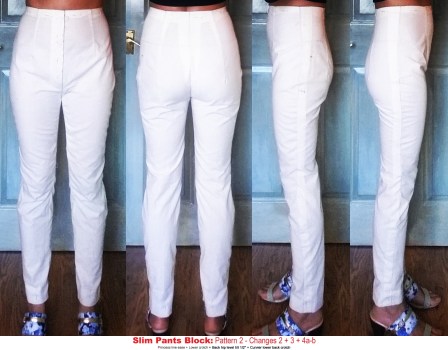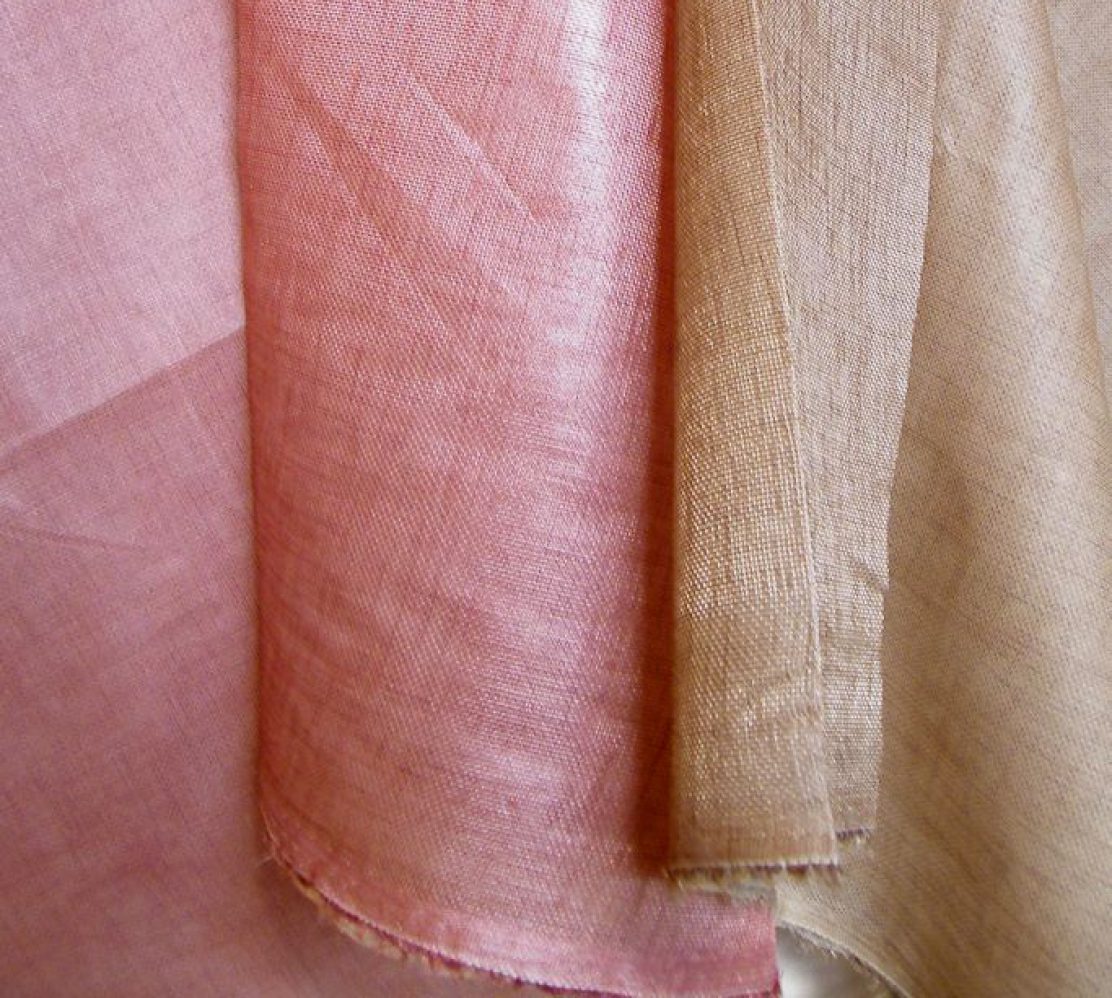I wish I could tell you that turning a 0-ease Pants Block into a Slim Pants Block is as simple as adding ease to the side seams & inseams. It was not. At least not for me. I did eventually get a block that I’m OK with. But it took many many muslins & I’ve lost count of the tweaks.
So no tutorial. Just some mug shots demonstrating the effect of key alterations I tried. You be the judge of what you would be happy with if you try to do the same. Keep in mind that variable natural lighting may have affected how the muslin looked in the mug shots. And of course the same alterations may have different effect on different body shapes. Hopefully you will get to your happy point more quickly than I did.
Since this is a long & tedious road, let’s start with the destination – then you can skip the journey if details send you to zzzz…..
Slim Pants Block (for non-stretch wovens)
the road from 0-ease Pants Block
Apology for not giving step-by-step rationale for why I tried certain tweaks. The road was too windy & the journey too long ago. Plus I’ve threw away the WIP patterns in a fit of tidying up. In general, I was trying to get rid of wrinkles and add enough wearing ease. I’ve listed all the steps I noted down. The one crossed out were tweaks abandoned, mostly because they didn’t seem to make any difference.
the prep before the journey
Comparing old RTWs & pants made so far…
- Best fit seems to be the high street wide leg pants in drapy wool crepe. Torso & crotch was still quite fitted, but the legs were loose. There was hardly any puddling. Interestingly the back crotch fork area is stretched. Not sure if this was stretched during wears or if it was part of the design.
- The designer fitted pants in stretch wool doesn’t fit so well. I got the usual draglines in the crotch & thigh area front & back. Even with stretch fabric, the thigh is still larger than my wearable muslins. But the drapy fabric helps make the legs look slimmer. BTW pardon my hot cross bum. Gotta sort out new undies now my behind has gotten more droopy & squishy }:-)
- Both RTW pants have shorter crotch height, crotch length, shallower back crotch curve (not so scooped) than my wrap. Yet they still feel comfortable enough. Actually they’re closer to my crotch height measurement. For some reason the wrap derived 0-ease pants block ended up about 1″ longer in crotch height than by measurement.
- My previous Burda 2015-11-107 fits better than the designer pants, but this was achieved through over-tight waist-to-hip + back princess shaping. Even then slight wrinkling in back thigh, not to mention weird pooling at front crotch – thigh inseam.
Research trouser fitting on Cutter & Tailor…
Granted, most discussion are about men’s trousers. But some of the basic fitting principles probably still apply. These influenced my decision to shift the knee match-points in most of my muslins & subsequent makes based on this Block. In my wrap, the front knee level is lower than the back knee level. I don’t actually manage to match the wrap knee levels precisely, I just try to reduce the difference as much as possible with iron work stretching-shrinking the side seam & inseam lines.
- Slim cut trouser question – 3022
- How the knee width of trouser legs effects the width of the crotch – 3587
- Trousers cutting for varied feet angles – 1886
- First rundschau trouser – 2879
- Trouser Fitting – Horseshoe Fold – 4122
- Trouser Fitting – Too Crooked Undersides – Insufficient Ironwork – 4114
- Trouser Fitting: Seat Seam Pulls into the Gap – 4142
- Trouser Block fit alterations – 793
- Third attempt at trousers, criticism welcome – 3585
- Women’s Cutter and Tailor – 16
- The Trouser and Waistcoat Forum – 18
- The Basic Apprentices’ Forum – 26
Pattern 1
Don’t ask. This was a stillborn. Didn’t even made it into muslining.
Pattern 2

0) 0-ease Pants Block
1) Add ease at side seam (1/2″ total at waist, widened to 1-1/2″ total at hip)
2) Add ease at darts / princess line instead, with bigger darts (same amounts)
3) Lowered crotch 1/4″
4a) Back hip tilt – pivot at side seam at hip level 1/2″
4b) Curvier & lower back crotch (dotted line)
5a) Back hip tilt – pivot at side seam at bum crease level 1/2″
5b) Add crotch inseam ease 1/8″
6a) Back hip tilt – pivot at side seam at bum crease level 1″
6b) Curvier & higher back crotch + Add leg ease at inseam (1/4″ with extra from thigh up)
6c) Right leg no shifting of match point / ironwork
7a) Straighten legs + Add more ease at inseam from knee up + Curvier Back crotch
7b) Right front add 1/2″ more ease above mid thigh with deeper dart






Pattern 3

8a) Add more ease at inseams (1/4″ – 1/ 2″) + Split darts into 2 per quarter + Increase Back dart width (1/4″ & shift side seam above hip to compensate) + Add more Front waist ease (1/8″ at side seam & decrease inner dart width by 1/8″)
8b) Right side raise waist 1/2″ at side seam
9a) Tried fitting book prominent calf adjustment (effectively deeper back crotch curve + lowered CB waist). No improvement.
9b) Legs straightened even more + Right side pivot at crotch at high hip level to increase side seam length
9c) Testing lengths & high-low waistline
9d) Final lengths for Wearable Muslin 1
⇒ Wearable Muslin 1
Gingham Capri with belt loop – Design Changes:
- Lower F waist (1″ difference between CF & CB)
- Contoured waistband 1-1/4″
- Capri length
- Fly front
- Slant-front pockets
- Belt loops
Assessment after days’ wear:
- bum-thigh become saggy, waist seem to tilt front up & back down
- knees baggy & twisted in front & excess pool in back just above knee – excess fabric from drooped back + angle of thigh vs calf too great & stacking of my upper over lower legs too wonky for slim but not skin tight fit to drape smoothly
Pattern 4

10a) More Back Hip Tilt pivoting at side seam bum crease additional 5/8″ (1-5/8″ total) + deeper curve (CB back to curved)
10b) Straighter CB above hipline
10c) Right raise waist 1/4″ at side seam
10d) Shift back thigh ease to inseam, increasing crotch length slightly + more ease from knee down, redistributed between F/B so both F/B knee down are straigher
⇒ Wearable Muslin 2
Gingham Capri without belt loop – Design Changes:
- Lower F waist (1″ difference between CF & CB)
- Contoured waistband 1-1/4″
- Capri length
- Fly front
- Slant-front pockets
Assessment after days’ wear:
- back crotch curve scoop seems too low
Pattern 5
11) Shallower back crotch curve + Less ease at thigh inseam
⇒ Wearable Muslin 3
Brown High-waisted Capri – Design Changes:
- Lower waist equal 1/2”
- Contoured waistband 2″
- Capri length
- Side invisible zip
- Side-seam pockets
⇒ Wearable Muslin 4
Brown Mid-rise with Hem Zips – Design Changes:
- Lower waist equal 3”
- Contoured waistband 1-1/4″
- Extended length
- Fly front
- Slant-front pockets
- Hem zippers
Assessment after days’ wear:
- Weird pooling at front crotch
- Waist still seem to tilt front up & back down.
In high-waist version, this caused waist to stick out in the back
In low-waist version, this caused more bagginess in bum-thigh area
This problem made these 2 rather uncomfortable to wear.
Possible causes… - waist to high hip ease + contoured waistline (low front high back) that enlarged waist further = waistline sits lower than intended
- waist ease + full tummy + flat lower back = waistline level even out front-back or even tilt towards skinnier parts – higher in front & lower in back, resulting in back crotch not sitting as intended, drooping causing excess length further down
More hypothesis to test…
- Not adding ease at waist-to-high-hip OR assume ease means pants will hang lower on waist evenly, so shorten evenly above hip
- Try 0 ease back + front with pleat – ie all ease on front ???
- Don’t do high-low waist unless waist-to-high-hip is skin tight & relies on fabric give for ease in this area.
- Wider legs especially back thigh to calf so fabric doesn’t have to bend to conform to leg shape & ending up with fabric puddle instead above the knee & front twist at the knee – wide enough cone to skim over all curves
- Reduce back crotch scooping, stretch back crotch fork if possible, raise crotch level a little
Pattern 6

12a) Reduce Back Hip Tilt at crease level by 3/8″ (1-1/4″ total)
+ Add Front Hip Tilt at hip level 1/4″
+ Shallower Back crotch curve
+ Reduce Back inseam thigh ease
12b) Front Hip Tilt at hip level 3/8″ more (5/8″ total)
+ Remove Back ease above high hip
12 c) Testing flared legs
12 d) Testing high-low waist & different rise…settled on:
CB 3/4″ higher than CF
mid-rise = 1″ — 1-1/2″ — 1-3/4″ lower than high-rise (waist)
low-rise = 1″ lower than mid-rise
ditch the extra-low-rise (1″ lower than low-rise)
+ Reduce Front ease above hip to 1/2″ at waist when lowering waist





Pattern 7 (final)
I thought I was done after Patter 6. Unfortunately shortly after I grew my donut waist. So a bit more adjustment was called for.
13) Shift crotch inseam 1/4″ to Back tapering to nothing at mid-thigh
+ shave 1/8″ off thigh side seam
+ increase Front flare 1/8″ below knee at inseam & side seam
+ straighten CF crotch adding 1/4″ ease at Front hip
+ straighten CB crotch adding 1/8″ ease at waist & deeper curve


Assessment after days’ wear:
- Although there’s still slight bagging under the bum, I’m calling it done.
- At least front crotch now looks normal.
- It’s not as slim as I would have like, but can’t be helped if I want to be able to sit down.
Finishing up
- Traced these onto card paper.
- Broken the Front & Back pieces into components so I can mix & match style – eg different rises, dart options, leg styles below knee. This also make the Block easier to store in a small place. I don’t have the luxury of a rack of hanging full Block/Pattern pieces.
- No seam allowance so that I can trace the combination I want to create fashion patterns.
Unfortunately I made a mistake when tracing. Instead of the high-low waistline of Wearable Muslin 5, I traced even level waistlines. No wonder the two pants/trousers I made using this Block came out less comfy than WM5. I only discover this as I prepared the illustrations for this post. Oops. Thankfully with the component approach I only need to redo the above hipline components.


















































































 0-ease Stable Knits Darted Fitted Top Block (Bodice & Sleeve)
0-ease Stable Knits Darted Fitted Top Block (Bodice & Sleeve)

















